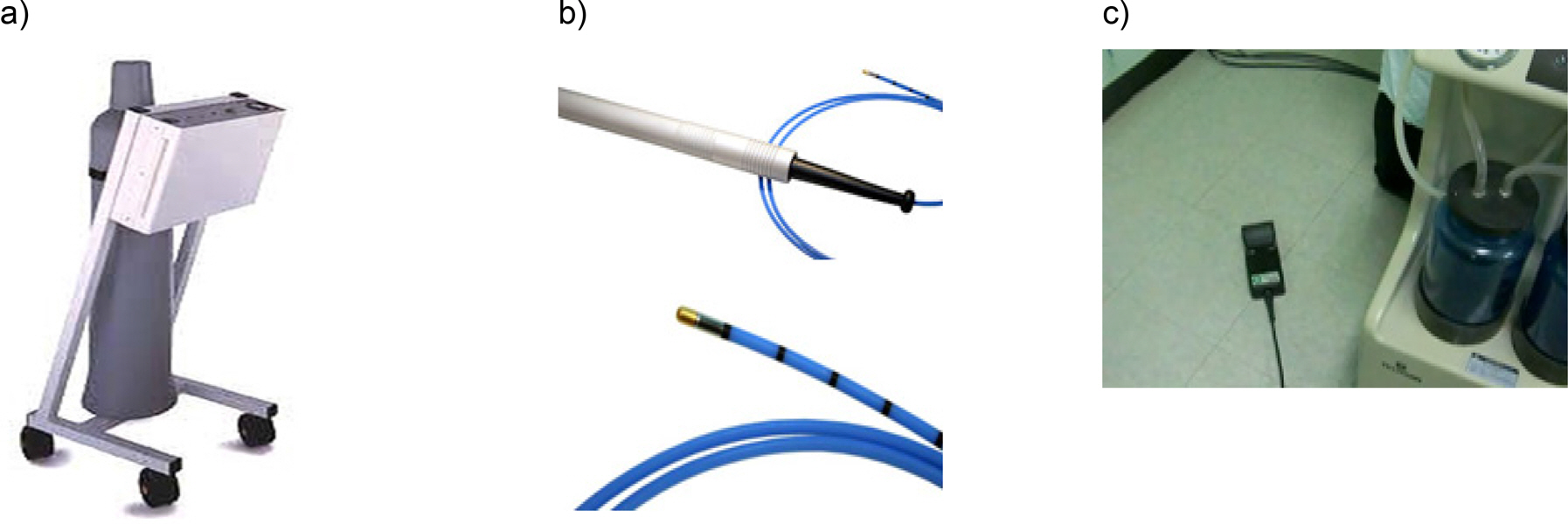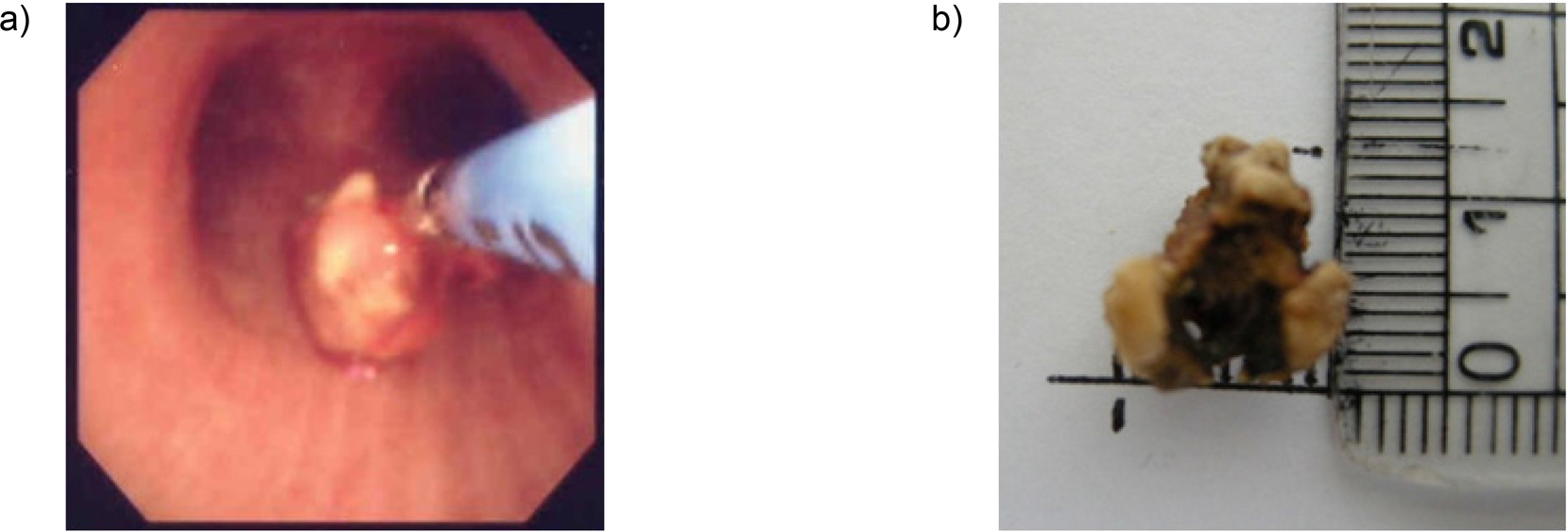Kosin Med J.
2014 Jun;29(1):31-36. 10.7180/kmj.2014.29.1.31.
Efficacy of Foreign Body Removal using a Cryoprobe in Flexible Bronchoscopy
- Affiliations
-
- 1Department of Internal Medicine, College of Medicine, Kosin University, Busan, Korea. oaks70@daum.net
- KMID: 1882436
- DOI: http://doi.org/10.7180/kmj.2014.29.1.31
Abstract
OBJECTIVES
Endobronchial foreign body impaction is a medical emergency because of the air way obstruction. Therefore, immediate foreign body removal is crucial in such situations. Recently, there have been several reports about cryoprobe use as a tool for removal of foreign bodies. In this study, we determined the efficacy and complications of foreign body removal using a cryoprobe during flexible bronchoscopy.
METHODS
This is a retrospective review of 27 patients who visited Kosin University Gospel Hospital from August 2007 to August 2010 with respiratory symptoms due to a foreign body in the airway. There were 17 males and 10 females, aged from 7 to 78 years. The foreign bodies were more frequently located (55%) in the right bronchus. The cryoprobe was inserted through the forceps channel of the flexible bronchoscope under local anesthesia. The lesion was quickly frozen for 5 seconds at -80degrees C, and the bronchoscope was removed with the probe after crystal formation on the contacted area.
RESULTS
The success rate of removal of foreign bodies was 85% (23/27) using the cryoprobe. One case of broncholith did not undergo attempted removal because of the possibility of excessive hemorrhage by the tight bronchus impaction, and three cases (plastic,silicon,and implant) failed due to limited crystal formation. There were no severe hemorrhages, arrhythmias, or casualties during the procedure.
CONCLUSIONS
The removal of foreign body using a cryoprobe during flexible bronchoscopy was shown to be safe and effective. The nature of the material should be attempted before removing a foreign body.
Keyword
MeSH Terms
Figure
Reference
-
1. Son CY, Wee JO, Kim SO, Oh IJ, Park CM, Kim KS, et al. A Retrospective Review of Tracheobronchial Foreign Bodies. Tuberc Respir Dis. 2005; 58:600–6.
Article2. Lee JH, Ahn JH, Shin AY, Kim SJ, Kim SJ, Cho GM, et al. A Promising Treatment for Broncholith Removal Using Cryotherapy during Flexible Bronchosopy: Two Case Reports. Tuberc Respir Dis. 2012; 73:282–7.
Article3. al-Majed SA, Ashour M, al-Mobeireek AF, al-Hajjaj MS, Alzeer AH, al-Kattan K. Overlooked inhaled foreign bodies: late sequelae and the likelihood of recovery. Respir Med. 1997; 91:293–6.
Article4. Rafanan AL, Mehta AC. Adult airway foreign body removal. What's new? Clin Chest Med. 2001; 22:319–30.
Article5. Ramirez-Figueroa JL, Gochicoa-Rangel LG, Ramirez-San Juan DH, Vargas MH. Foreign body removal by flexible fiberoptic bronchoscopy in infants and children. Pediatr Pulmonol. 2005; 40:392–7.6. Lamaze R, Tréchot P, Martinet Y. Bronchial necrosis and granuloma induced by the aspiration of a tablet of ferrous sulphate. Eur Respir J. 1994; 7:1710–1.
Article7. Debeljak A, Sorli J, Music E, Keceli P. Bronchoscopic removal of foreign bodies in adults: experience with 62 patients from 1974-1998. Eur Respir J. 1999; 14:792–5.
Article8. Burton EM, Brick WG, Hall JD, Riqqs W Jr, Houston CS. Tracheobronchial foreign body aspiration in children. South Med J. 1996; 89:195–8.
Article9. Shivakumar AM, Naik AS, Prashanth KB, Shetty KD, Praveen DS. Tracheobronchial foreign bodies. Indian J Pediatr. 2003; 70:793–7.
Article10. Ramírez-Figueroa JL, Gochicoa-Rangel LG, Ramírez-San Juan DH, Vargas MH. Foreign body removal by flexible fiberoptic bronchoscopy in infants and children. Pediatr Pulmonol. 2005; 40:392–7.
Article11. Lyu J, Song JW, Hong SB, Oh YM, Shim TS, Lim CM, et al. Bronchoscopic Cryotherapy in Patients with Central Airway Obstruction. Tuberc Respir Dis. 2010; 68:6–9.
Article12. Hsu WC, Sheen TS, Lin CD, et al. Clinical experiences of removing foreign bodies in the airway and esophagus with a rigid endoscope: a series of 3217 cases from 1970 to 1996. Otolaryngol Head Neck Surg. 2000; 122:450–4.
Article13. Cohen SR, Herbert WI, Lewis GB Jr, Geller KA. Foreign bodies in the airway: five-year retrospective study with special reference to management. Ann Otol Rhinol Laryngol. 1980; 89:437–42.14. Oguzkaya F, Akcali Y, Kahraman C, Bilgin M, Sahin A. Tracheobronchial foreign body aspirations in childhood: a 10-year experience. Eur J Cardiothoracic Surg. 1998; 14:388–92.15. Gorenstein A, Neel HB, Sanderson DR. Transbronchoscopic cryosurgery of respiratory structures: experimental and clinical studies. Ann Otol Rhinol Laryngol. 1976; 85:670–8.
Article16. Limper AH, Prakash UB. Tracheobronchial foreign bodies in adults. Ann Intern Med. 1990; 112:604–9.
Article17. Kim YH, Choi CW, Choi HS, Park MJ, Kang MH, Yoo JH. Clinical Features of Tracheobronchial Foreign Bodies in Adults according to the Risk of Aspiration. Tuberc Respir Dis. 2008; 64:356–61.
Article18. Baharloo F, Veyckemans F, Francis C, Biettlot MP, Rodenstein DO. Tracheobronchial foreign bodies: presentation and management in children and adults. Chest. 1999; 115:1357–62.
- Full Text Links
- Actions
-
Cited
- CITED
-
- Close
- Share
- Similar articles
-
- A Case of Removal of Pushpin by Flexible Bronchoscopy
- A Case of Occult Foreign Body Lodged in Bronchus for a Long Period and Removal by Flexible Bronchoscopy
- A case of obstructive pneumonia due to fish vertebrae aspirated into both bronchi
- Usefulness of Flexible Bronchoscopy in the Diagnosis of Tracheobronchial Foreign Bodies in Children
- A Case of Formation of Interbronchial Fistula Complicated by Long-standing Bronchial Foreign Body




